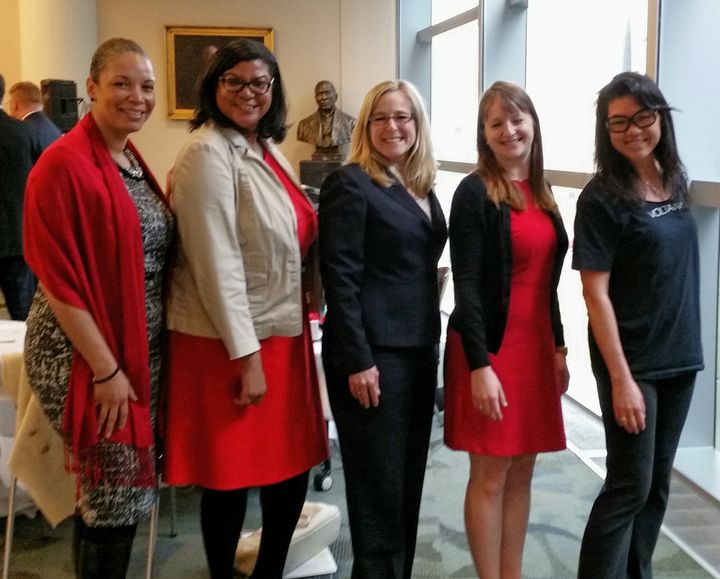
The Indiana panelist posse
It was the first time I had ever sat in front of a roomful of people applying for grants, board members, funders and the curious public who were hanging on every word I said as if their lives depended on it.
Why was this so unnerving?
Well, usually a grant review takes place privately so that the panelists can have an open discussion or sometimes an argument about the proposals sitting on the table.
This was not the case at this Arts Council of Indianapolis grant panel I was invited to be on.
It forced me, as well as the other panelists, to really think about what I felt was truly important to share and how to say it in a public setting before opening my mouth.
I began to notice that all of us were reacting to the same things as we reviewed the stack of grants. For anyone who took notes during the session, there was probably a goldmine of insights they could put to good use in the next grant they wrote.
One particular thing kept coming up over and over again for us. When we ran across proposals that did this well, you could see our faces light up. And you could see our appreciation reflected in the scores.
Many people think of their proposals as their one shot to do something really big and meaningful. To reach the widest audience with something for everyone.
Big mistake.
Why? This makes their focus vague. It makes me wonder how well can you do something if you are doing so much? And for so many people?
Yet, you want your project to have a big impact. You feel like you are leaving out so many people and potential audiences when you start to limit who and what your project is for. You start to wonder if your proposal will not be as appealing if you do less and for less people.
What was that one thing we all liked?
It was the courage to go small and be specific.
Not small in impact, but small in knowing exactly what the project's intentions are and who they are for. By going small, I mean setting boundaries around what the single focus of your project is and who it is for.
Jeff Goins, a writer and the creator of Intentional Blogging, a course for writers, offers this advice:
"And if I were to ask you, what do you write about? You might have an answer. But if I were to ask you, what’s the point? What’s your argument? Would you have an answer? This is important. This is something that all great bloggers do is whether it’s explicit or implicit. They’re not just saying something that they believe in. They’re trying to prove a point. They’re trying to convince you of something even if it’s memoir. Even if they’re telling a story, there is some lesson to it. And that’s the objective.
And, so, the question isn’t just, “What are you writing about?” Or, “How are you focusing?” It’s, “What’s the point?” What are you trying to say? What are you trying to convince the reader of?"
The rule of thumb is this: The more you narrow your focus, the more you broaden your audience.
Feels counterintuitive, doesn't it?
It actually wins you more points because it forces you to go in deep rather that wide. You will be able to sharpen your focus and give greater detail and specificity to why it is so important, who it is for and how it will happen.
Think about it.
Here we are, a group of 5 people from around the country who don't know much about the art scene in Indiana, making decisions about who gets a grant and who doesn't. This is something many people don't think about - it is so important for you to always assume nobody knows who you are. Write your proposal with a few simple, clear goals and a distinct audience we can see in our mind. The more specific you can be, the more detailed a picture you can paint for us, the better.
Here's 3 things to help you get started:
Pick 1 outcome
Ask yourself a tough question: Why are you doing this?
Here's a hint: Your answer should be about making life better or more beautiful for someone.
Do you create art to awaken a sense of wonder in your viewer? Will the story you write encourage someone to open their mind to new experiences?
A person looking at your painting or listening to your music must feel something that changes them.
See the change
Think of what you want someone to look like, sound like and talk like after experiencing your art. Are they inspired? Do they see colors differently? Will they go home and think about all of the journeys made by people to make it possible for them to call this place their home?
Once you know this, you can create a project that best delivers this outcome to these people.
Do less, better
Everything you do must move you closer to delivering this outcome. To making it possible for people to change. Do more of this. Anything else is not necessary.
Hoong Yee is a writer who draws. She is the author of Rabbit Mooncakes, a children’s picture book and the Executive Director of the Queens Council on the Arts. Hoong Yee is married to a nice Jewish boy and they live in Rockaway Beach, NY with their family. Get her FREE Master Grant Strategy Worksheet and a weekly dose of insights from a grant reviewer’s point of view. Visit her website at hoongyee.com
